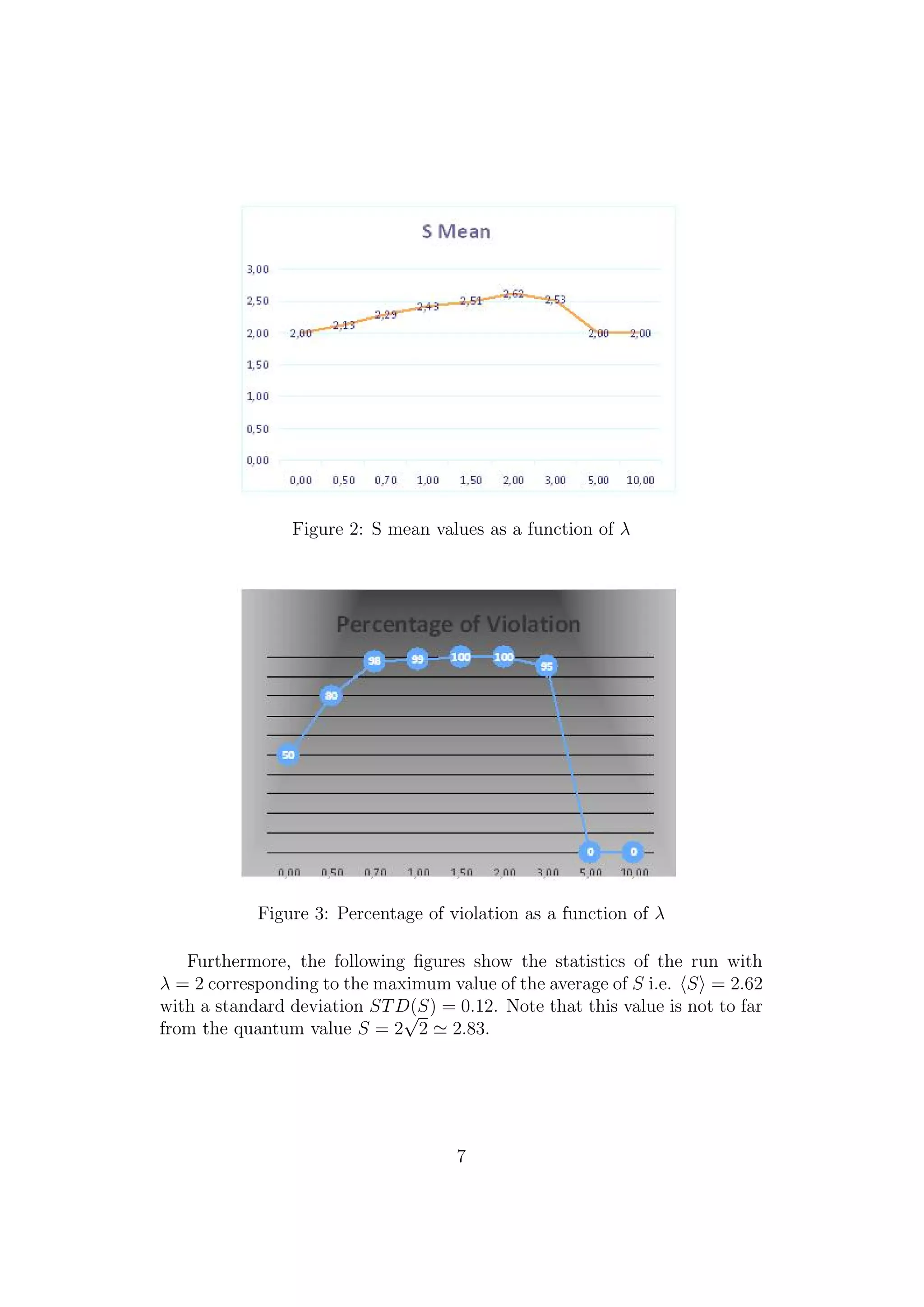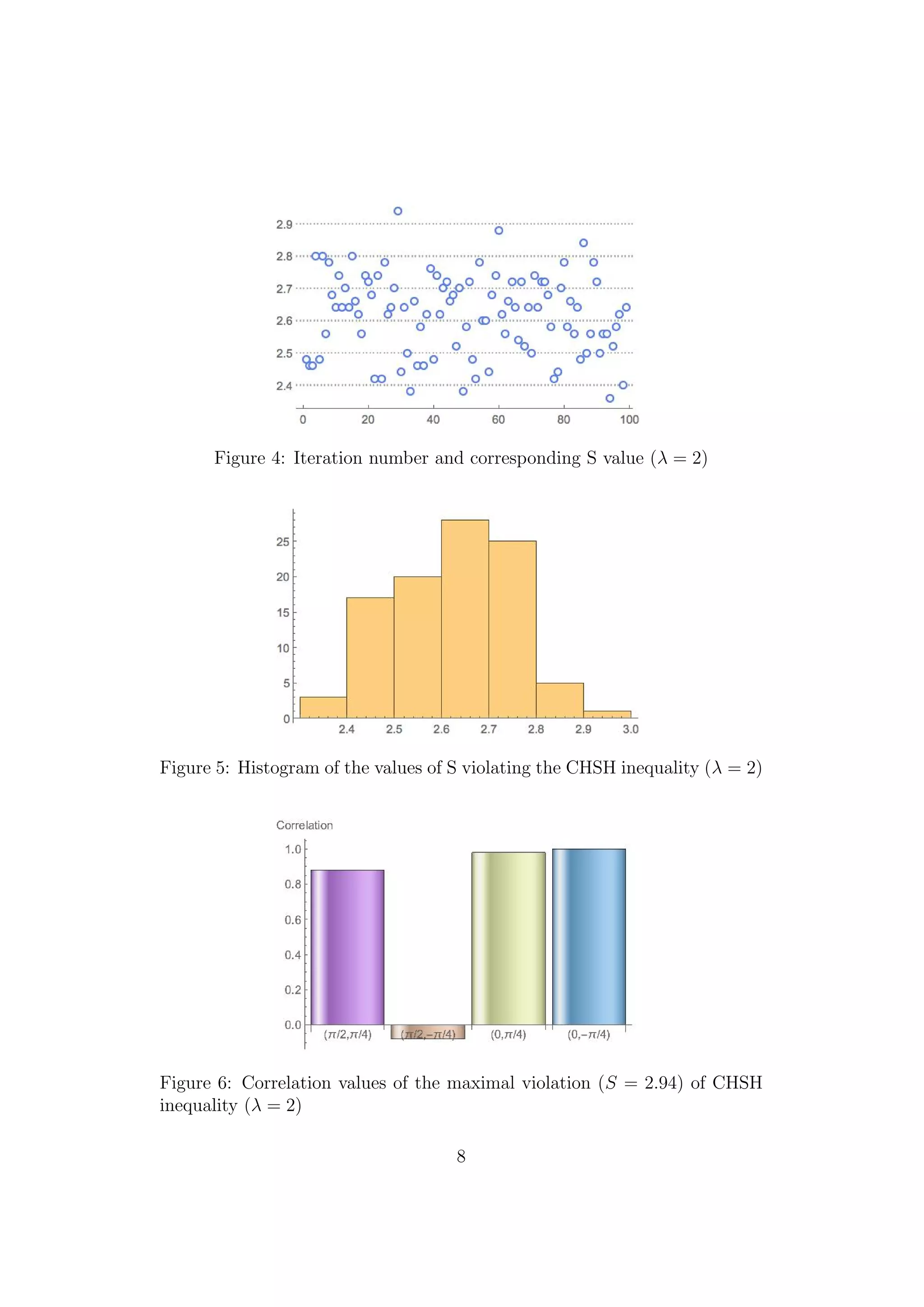The document discusses a classical non-local linear dynamical system designed to simulate a two-channel quantum coincidence experiment, demonstrating violations of Bell's inequality, particularly in the form of the Clauser-Horne-Shimony-Holt (CHSH) inequality. The research indicates that these violations can reach up to 100% depending on a parameter that introduces non-locality tied to initial conditions. The findings suggest that the violation outcomes depend significantly on the chosen angles for measurements, with implications for understanding the parallels between classical and quantum systems.
![A non-local linear dynamical system and
violation of Bell’s inequality
Renzo Mosetti∗
University of Trieste
Department of Mathematics and Geoscience, Via Weiss, 4, 34127, Trieste, ITALY
February 23, 2018
Abstract A simple classical non-local dynamical system with random
initial conditions and an output projecting the state variable on selected axes
has been defined to mimic a two-channel quantum coincidence experiment.
Non-locality is introduced by a parameter connecting the initial conditions
to the selection of the projection axes. The statistics of the results shows
violations up to 100% of the Bell’s inequality, in the form of Clauser-Horne-
Shimony-Holt (CHSH), strongly depending on the non-locality parameter.
Discussions on the parallelism with Bohmian mechanics are given.
∗
rmosetti@inogs.it
1
arXiv:1802.08074v1[physics.gen-ph]21Feb2018](https://image.slidesharecdn.com/anon-locallineardynamicalsystemand-180227111347/75/A-non-local-linear-dynamical-system-and-violation-of-Bell-s-inequality-1-2048.jpg)
![1 Introduction
The Bell inequality [1] [2] is a milestone in the development of the post EPR
[3] discussion on the completeness of Quantum Mechanics. The literature on
the subject is huge and laboratory experiments confirm the violation of the
inequality in the quantum world. Moreover, there are also several papers on
the occurrence of Bell’s inequalities violation in classical random systems [4],
[5], [6], [7], [8] . In this contest, the Accardi et al. papers, [9], [10] have raised
an animate debate due mainly by Gill ( [11], [12] ). Usually, the experiments
are based on computer randomness generation while in this paper we perform
correlation experiments much possible close to the concept of the evolution of
a dynamical state which resembles the causal Bohmian interpretation of EPR
where initial conditions of the wave function appear to be crucial. In fact,
the complete Bohm theory [13] is based on a deterministic dynamics and one
could introduce randomness by randomizing the initial conditions according
to the well known Born’s rule. So, the randomness of the quantum theory
is due to our ignorance of initial conditions. The numerical experiment here
proposed lies within these lines. In the first paragraph a simple two dimen-
sional state-space dynamical system with a scalar output is defined. In the
second paragraph we define the experiment which mimics the behavior of the
quantum two-channel polarized photon experiment for testing the Clauser-
Horne-Shimony-Holt (CHSH) inequality [14] . The third paragraph contains
the set-up of the simulator and algorithm used to compute correlation among
measurement pairs. The fourth paragraph presents the obtained results in
terms of the statistics of the outputs. Finally, some conclusions and open
questions are given.
2 The state-space linear system model
Consider the following two-dimensional linear dynamical system in the state-
space representation:
˙X = AX
Y = CX
(1)
A =
0 1
−1 0
; C = cos(θ) sin(θ) ; XT
:= x1 x2
The formal solution for the state propagation starting with an initial condi-
tion: X0 := X(t = 0) is:
X(t) = X0etA
(2)
2](https://image.slidesharecdn.com/anon-locallineardynamicalsystemand-180227111347/75/A-non-local-linear-dynamical-system-and-violation-of-Bell-s-inequality-2-2048.jpg)

bi = sign[yb(t = t1)](i = 1, 2)
(4)
The idea is to test, by means of a series of experiments, whether it is pos-
sible to violate the Bell’s inequality by testing the experimental correlations
defined in a standard way as:
E = (N++ + N−− − N+− − N−+)/(N++ + N−− + N+− + N−+) (5)
Where: N++ means that (a = +1) ∧ (b = +1) and so on. Actually, being the
experiment a typical two-channel experiment, the CHSH inequality in the
following form is more suitable:
S = E(a1b1) − E(a1b2) + E(a2b1) + E(a2b2) 2 (6)
3](https://image.slidesharecdn.com/anon-locallineardynamicalsystemand-180227111347/75/A-non-local-linear-dynamical-system-and-violation-of-Bell-s-inequality-3-2048.jpg)
![Furthermore, the derivation of the original Bell inequality assumes perfect
anticorrelation of entangled photon measurements in the EPR setup. The
CHSH inequality has the reputation of being superior for all purposes. It
is harder to violate and its derivation does not need anti-correlation. The
following hypotheses are assumed to derive the CHSH inequality :
Hidden variables: The results of any measurement on any individual sys-
tem are predetermined;
Non-Locality: It is well known that non-locality is necessary to reproduce
the quantum mechanics in a deterministic context. So, non-local effect are
here introduced in the initial conditions (hidden variables) by the following
rule:
x1(0) = r1 + λ cos(ϑ1);
x2(0) = r2 + λ cos(ϑ2);
where: r1 and r2 are Gaussian random noises with 0 mean and unitary vari-
ance; and λ cos(ϑ1) and λ cos(ϑ2) constitute the dependence of the initial
conditions on the chosen angle by both Bob and Alice experimental set-
ting. The violation of a Bell inequality guarantees that the observed outputs
are not predetermined and that they arise from entangled quantum systems
that possess intrinsic randomness. As for the standard tests for quantum
systems, the experiments consist on four sub-experiments (each for any cor-
relation pair) and the state model is the same both for Alice and Bob who
do not know the system state and perform the measurements separately at
the same time t1. To randomize the system, the initial condition of the state
variable X0 is picked-up from a normal distribution with zero mean and uni-
tary variance according to the non-local position described in the formula
above in every run of each sub-experiment. To obtain a significant statistics,
a large number of experiments have to be performed by iterating the pro-
cedure. In an algorithmic language, the process can be synthesized as follows:
Set λ
For n=1,Nmax
For i=1,M
Do [random X0, State propagation⇒ measurement a1 and b1]
end
Compute correlation according to (5)E(a1b1)
4](https://image.slidesharecdn.com/anon-locallineardynamicalsystemand-180227111347/75/A-non-local-linear-dynamical-system-and-violation-of-Bell-s-inequality-4-2048.jpg)
![For i=1,M
Do [random X0, State propagation⇒ measurement a1 and b2]
end
Compute correlation E(a1b2)
For i=1,M
Do [random X0, State propagation⇒ measurement a2 and b1]
end
Compute correlation E(a2b1)
For i=1,M
Do [random X0, State propagation⇒ measurement a2 and b2]
end
Compute correlation E(a2b2)
Compute S(n)
end
Compute statistics on S
4 Running the model
We chose as angles for the coincidence measurements the ones which, accord-
ing to the quantum theory, give S = 2
√
2.
{θ} = {
π
2
, 0,
π
4
, −
π
4
} (7)
The importance of this configuration lies on the fact that it corresponds to
a situation which cannot be reproduced by a hidden variable theory. We have
performed 100 (Nmax) independent runs with M=100 yielding hundred mea-
surement pairs in each sub-experiment. The MathematicaTM
software has
been used for the simulations and for the statistical analyses of the outputs.
In what follows, the measurement pairs with respect to the chosen angles are
reported in details.
First coincidence measurements
a1 = sign[ya(t1)] = cos
π
2
sin
π
2
x1(t1)
x2(t1)
b1 = sign[yb(t1)] = cos
π
4
sin
π
4
x1(t1)
x2(t1)
(8)
5](https://image.slidesharecdn.com/anon-locallineardynamicalsystemand-180227111347/75/A-non-local-linear-dynamical-system-and-violation-of-Bell-s-inequality-5-2048.jpg)
![Second coincidence measurements
a1 = sign[ya(t1)] = cos
π
2
sin
π
2
x1(t1)
x2(t1)
b2 = sign[yb(t1)] = cos −
π
4
sin −
π
4
x1(t1)
x2(t1)
(9)
Third coincidence measurements
a2 = sign[ya(t1)] = cos(0) sin(0)
x1(t1)
x2(t1)
b1 = sign[yb(t1)] = cos
π
4
sin
π
4
x1(t1)
x2(t1)
(10)
Fourth coincidence measurements
a2 = sign[ya(t1)] = cos(0) sin(0)
x1(t1)
x2(t1)
b2 = sign[yb(t1)] = cos −
π
4
sin −
π
4
x1(t1)
x2(t1)
(11)
4.1 Results: CHSH inequality violation
For each selected values of 0 ≤ λ ≤ 10 the process, as described above, has
been run and the results obtained of the overall expected value of S and on
the percentage of CHSH violations and are reported in the Figures 2 and 3
respectively. By performing several runs, also by increasing the number M
of measurements pairs and the number of iterations, the overall statistics do
not show any significant variation.
6](https://image.slidesharecdn.com/anon-locallineardynamicalsystemand-180227111347/75/A-non-local-linear-dynamical-system-and-violation-of-Bell-s-inequality-6-2048.jpg)



![mechanics. Bohmian mechanics is a deterministic theory where a probabilis-
tic element is introduced as probability is introduced into classical mechan-
ics. The observer does not possess the full information about the true initial
configuration of the system, but rather he has to retreat to a probability den-
sity. (See for example: [15] for a criticism of Bohmian theory). Of course,
we cannot conclude that our results might imply adequacy or inadequacy of
Bohmian point of view.
References
[1] Bell, J. S.: On the Einstein Podolsky Rosen paradox. Physics(3),
195–200 (1964); reprinted in Bell,J.S. Speakable and Unspeakable in
Quantum Mechanics. 2nd ed., Cambridge: Cambridge University.
[2] Bell, J.S.: On the problem of hidden variables in quantum mechanics.
Rev. Mod. Phys. 38, 447–452 (1966).
[3] Einstein, A.; Podolsky, B.; Rosen, N.: Can Quantum-Mechanical De-
scription of Physical Reality be Considered Complete? Phys. Rev.
47(10), 777-780 (1935).
[4] Aerts, D., 1982, Example of a macroscopical situation that violates Bell
inequalities”, Lett. Nuovo Cim., 34, 107.
[5] Aerts, D. and Durt, T., 1994, Quantum. classical and intermediate, an
illustrative example”, Found. Phys. 24, 1353 - 1368.
[6] J. Kofler and C. Brukner, Conditions for Quantum Violation of Macro-
scopic Realism, Phys. Rev. Lett. 101, 090403 (2008).
[7] Vongehr, S.: Quantum Randi Challenge and Didactic Randi Challenges
arxiv.org/abs/1207.5294v3 (2012).
[8] L. Clemente and J. Kofler, Necessary and sufficient conditions for macro-
scopic realism from quantum mechanics, Phys. Rev. A 91, 062103 (2015).
[9] Luigi Accardi, Massimo Regoli:Locality and Bell’s inequality. Preprint
Volterra, N. 427 (2000) quant-ph/0007005; an extended version of this
paper, including the description of the present experimen will appear
in the proceedings of the conference Foundations of Probability and
Physics, Vaxjo University, Sweden, November 27 - December 1 (2000),
A. Khrennikov (ed.), World Scientific (2001).
10](https://image.slidesharecdn.com/anon-locallineardynamicalsystemand-180227111347/75/A-non-local-linear-dynamical-system-and-violation-of-Bell-s-inequality-10-2048.jpg)
![[10] L.Accardi, K.Imafuku, M.Regoli: On the physical meaning of the
EPR–chameleon experiment, Infinite dimensional analysis, quantum
probability and related topics, 5 N. 1 (2002) 1–20; quant-ph/0112067.
[11] Gill, R.D.: Time, Finite Statistics, and Bell’s Fifth Position. In Proc.
of Foundation of Probability and Physics – 2 Ser. Math. Modelling in
Phys., Engin. And Cogn. Sci, 5, (2002) pp. 179-206. Vaxjo Univ. Press,
(2003).
[12] Gill, R.D.; Larsson, J.A.: Accardi contra Bell (cum mundi): The impos-
sible coupling. In Mathematical Statistics and Applications: Festschrift
for Constance van Eeden. Eds: M. Moore, S. Froda and C. L’eger, pp.
133-154. IMS Lecture Notes, Monograph Series 42, Institute of Mathe-
matical Statistics, Beachwood, Ohio (2003).
[13] Bohm, D., 1951, Quantum Theory, Prentice-Hall, Englewood Cliffs, New
York.
[14] Clauser, J.F.; Horne, M.A.; Shimony, A.; Holt, R.A.: Proposed Ex-
periment to Test Local Hidden-Variables Theories. Phys. Rev. Lett. 23,
880-884 (1969).
[15] Kim Joris Bostrom, Is Bohmian Mechanics an empirically adequate the-
ory? arXiv:1503.00201v2 [quant-ph] (2015).
11](https://image.slidesharecdn.com/anon-locallineardynamicalsystemand-180227111347/75/A-non-local-linear-dynamical-system-and-violation-of-Bell-s-inequality-11-2048.jpg)